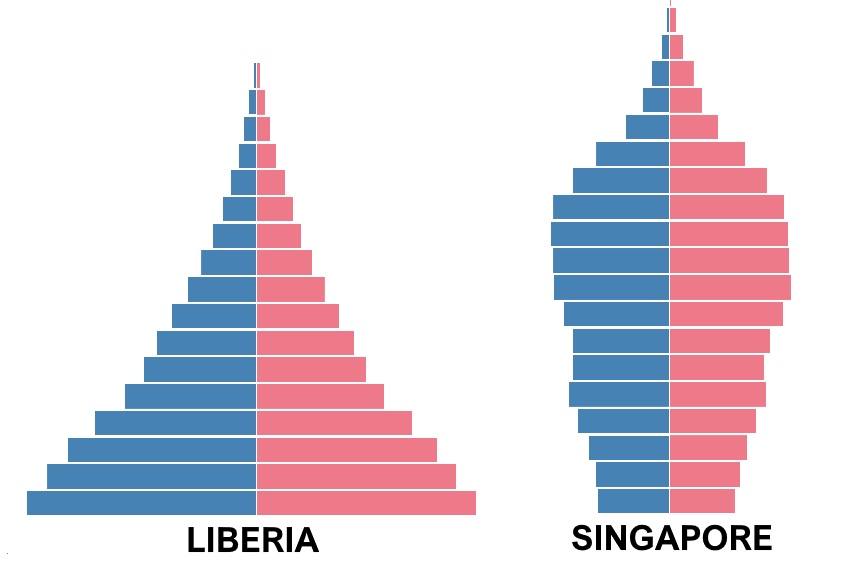Malaysians are having less kids than before! Here’s why that’s actually GOOD news

- 659Shares
- Facebook608
- Twitter7
- LinkedIn18
- Email10
- WhatsApp16
If you’re married and sick of people asking you when you’re gonna get a baby, well, READ ON.
Malaysians are having less children and growing old much faster than ever before. This news sparked some interesting conversations in the office about overpopulation, the environment, parenthood and even some sex tips (hint for future article? 😉 ), so we thought we’d share some of it with you.
And look, it’s time we had that talk. You know, the one dad tried to brush off? Yeah I’m talking about the birds and the bees. We’re going to talk about Pop, and, if we have the time, the Bee Gees.
When we say Malaysians are having less kids than ever before, we weren’t KIDding

Malaysia’s fertility has been dropping steadily since its founding in 1963. It reached 2.0 babies per woman in 2016 and 1.9 in 2018. This became news because we finally went below the normal replacement fertility rate which is 2.1.
After some digging, we found a report by the gomen in 1984 which wanted Malaysia’s population to reach 72-75 million by 2100, as they estimated that the fertility rate would drop below 2.1 by 2070. Well,it’s 2018 and we’re 52 years early!
What this means is that, for the foreseeable future, Malaysia’s population is going to grow slowly until it reaches the 42 millionth person, and it’s likely to stay that way or even shrink afterwards, far from the huuuuge 72 million we planned for! Anyway, if you like looking at maps, the UN has a pretty fun one you can play around with to compare with other countries.
So why aren’t people having more kids now? Because of two reasons mainly; time and money. The money families earn can’t keep up with the rising cost of living. Many educated folks and professionals also trend towards having less kids as they’re prioritizing careers and having children at older ages. It’s also why urban populations tend to have lower fertility rates compared to rural ones, and with Malaysia’s urban population estimated to hit 85 to 90% of the country by 2050, the fertility number is going to drop even lower. So how is this even a good thing?

Wait… But “Anak itu rezeki” kan?
A shrinking population… is bad cause we need more kids, right? Well actually, BECAUSE the fertility rate is dropping, Malaysia has been able to enjoy what’s known as a Demographic Dividend up until now. Because of good economic growth in the 80s, Malaysia had a Baby Boom, which means that there are lots of working-age adults today (when the going gets good, the goods get going 😉 ).
And when there are less kids being born, there are more adults who work compared to those who don’t (children and the old). The benefits include:
- Savings – No kids means more money to save or spend to stimulate the economy. Think of all the Starbucks and Bubble Teas ugaiz can get instead of buying diapers and milk powder.
- Better kids – With less children per family, parents can dedicate more resources to the children they have, leading to better education and healthcare for the next generation.
- Economic growth – More working adults compared to kids and the retired means higher GDP per capita and economic contribution.
Keep in mind that DD isn’t an instant thing. Not all countries are guaranteed to benefit from it, but Malaysia and Singapore certainly did. Interestingly enough, the Economist placed Malaysia as one of the 5 cheapest countries to buy a Big Mac in their Big Mac Index (BMI) a purchasing power parity indicator, not to be confused with the Body Mass Index (BMI), of which Malaysia is also the highest in SEA.

So what is purchasing power? In simple terms, it just means the amount of goods you can buy for one unit of currency. The Big Mac Index tells us that the Ringgit is undervalued because of how cheap a Big Mac is relative to other countries. Which means Malaysians’ purchasing power is prettyyy goood (aside from the part where McDs raised their prices silently earlier this year… so not that cheap anymore…)
So food is cheap, times are good, where’s the problem? Why so negative wan??? Welllllll……. We hope you’re able to see the one itsy-bitsy small problem with this…
What happens when all these kids get old?
Yeah, that huge adult working population of today? They’re gonna grow old some day too. And when that happens, current projections show that they’re going to outnumber the working population.
The Ageing Population is rising super fast. In a study of over 50 countries, Malaysia’s ageing population was the fastest growing, at 277% in 30 years, second only to Singapore at 372% (Why Singapore always number 1 wan… JK). While the growing ageing population is normal in developing economies, the scary aspect is just how fast it’s happening. If this sounds familiar, that’s because that’s currently happening to Japan on an unprecedented level. But really, how bad can it be?… About that, Japan’s been selling more adult diapers than baby diapers. Yeah for real.
This rapid population change is called a Demographic Timebomb. In Malaysia, around 25 thousand civil servants retire every year and this number is steadily going up. By 2050, taxpayers are going to have to spend a 100 Billion Ringgit a year on state pensions alone. Healthcare costs are expected to increase a lot too as more people enter old age. Malaysia currently spends about 4.4% of its GDP on healthcare, close to Singapore’s 4.9% but if things get worse, we might end up spending 10.9% like in Japan. As you can imagine, there are a lot of other butterfly-effect-like consequences which not even we can predict. The ageing population also forces governments to increase the age of retirement in order to keep as much of the workforce as possible, something Malaysia is already preparing to do it too.

To make matters worse, Malaysia faces other demographic issues such as a change in the ratio of races, especially as the ethnic Chinese and Indian populations continues to shrink (which we’ve covered in more depth here!).
Yeah all that stuff is kinda depressing, so let’s take a short break.

That was nice wasn’t it? Calm down yet? Good, because there’s no reason to panic… yet.
The UN estimates that the 12 billionth human wouldn’t be born at all.
This whole population change thing? It’s not new. Most countries go through this, known as a demographic transition, as they develop. The trends we mentioned above are a part of this transition. One way to look at this is from the perspective of overpopulation. If you’re unaware, here’s a very cool video about overpopulation and development by Kurzgesagt (We all have that friend who keeps complaining about overpopulation right?… Don’t forget to share this story 😉 )
They even mention Malaysia at 4:55! #MalaysiaBoleh
That said, even though food production can keep up with all the humans around, it’s a matter of fact that humans have a massive impact on the planet. Climate change, deforestation and ozone depletion are just some of them, so having a smaller population would go a long way to reducing our impact on the environment. Man’s effect on the times are quite obvious. Of course, we can’t ethically suggest going full Thanos, even if Infinity War made genocide look cool and relatable.

Our point is, with the way our population is trending, population control on the scale of China is unnecessary. As long as we solve the worker issue, a balanced and sustainable population is actually the ideal. Back to the worker issue, quite a few countries are about to hit that magical line where their ageing population outnumbers their working population. Mind you, most of these countries took many generations to get to this point whereas Malaysia is reaching this point much faster than initially predicted (Okay actually Singapore is faster, but this isn’t something to kiasu about k).
To show this, there’s a useful tool known as a population pyramid. The pyramid shows the ratio of people in a country by sex (male in blue and female in red) and age (the bottom of the pyramid represents the younger population, the top represent the old)

But wait, Singapore not pyramid oso!!! #Fakenews. That’s because of the demographic changes we mentioned earlier. To make some sense of this, think of the graphs as buildings. Way back in the ancient era, to build a tall building, they had to use a pyramid because only a wide base can support the height of the building. Nowadays, because of technology, we can build whatever weird-shaped building we want, and even protect them against natural disasters. You see, back then having lots of kids meant that more of them would survive, and they could help out in the farms and stuff. Nowadays, we don’t need children to boost the economy as mentioned earlier, so there’s less of an economic incentive to have children.

So how are we Stayin’ Alive?
Remember when we said these changes were happening fast? Well, see for yourself;

One solution is to rely on migrants for labour, as is the case in Germany. Immigration is a complex issue with its own set of problems, but even so it can only act as a temporary solution. Most migrants to Malaysia come from neighbouring Indonesia and Thailand, with Indonesian migrants making up the majority of migrants. Malaysia also acts as a migration hub in South East Asia, with migrants from all over SEA entering the country with the hopes of hopping over to Australia, Europe or the Americas eventually – like that one guy who got stuck in our airport for months.

Alternatively, automation may be an important tool in making up for the shrinking workforce, as is the case in Japan. This is expensive, however, and will require a lot of money and education to pull off, though it can and is already being done. While robot servants and workers might be the stuff of science fiction, mechanization and increasing automation in the manufacturing sector is sure to happen. The question then becomes, will it happen fast enough?

As for healthcare, encouraging healthier lifestyles (ps you can get a tax relief for gym membership fees!) and fighting diseases at the causes rather than treating them as they occur is necessary if we want to avoid the Japanese healthcare trap. More efficient and effective diagnosis and treatment is also needed, as current hospital standards aren’t good enough. That said, the gomen is trying to promote Malaysia as a fertility hub for medical tourism by 2020 because of the quality of it’s IVF (artificial insemination) services which have a higher success rate at 65% compared to the worldwide 50% average. Btw, if this is a route you’d like to take, they cost up to RM14,000.
We could also try creating incentives for young couples such as providing maternity leave and income tax deductions. Singapore even has a baby bonus! In Malaysia, some states offer a RM1,000 incentive to marry before the age of 35. You can also get a RM1,000 tax relief for each child you have. That said, these incentives don’t always work and it might be time to accept that a low fertility rate is normal.

Screencap of Bao by Pixar
Basically, far from the 70 million+ dream of previous governments, Malaysia’s population is set to max out at around 40 million, and we could focus on making each individual more productive through education and healthcare and focus on sustainable consumption, rather than population growth for growth’s sake. No, you don’t have to drive a Prius and no, you don’t have to stop having kids. Just make that you have the will and resources to ensure that they have a fulfilling life.
And hey, Dr M is actually getting the country talking about safe sex outside of form 5 biology classrooms. Regardless of whether you’re a brother or a mother, family planning is a good thing. So don’t worry too much about people growing old. And you know what never gets old? The Bee Gees. Ah, ha, ha, ha~ Stayin aliveeeee~
- 659Shares
- Facebook608
- Twitter7
- LinkedIn18
- Email10
- WhatsApp16
